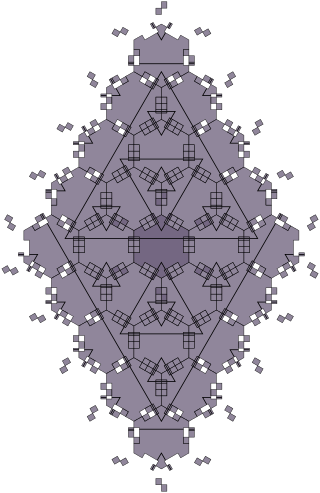Top Qs
Timeline
Chat
Perspective
Socolar–Taylor tile
Aperiodic tile From Wikipedia, the free encyclopedia
Remove ads
The Socolar–Taylor tile is a single non-connected tile which is aperiodic on the Euclidean plane, meaning that it admits only non-periodic tilings of the plane (due to the Sierpinski's triangle-like tiling that occurs), with rotations and reflections of the tile allowed.[1] It is the first known example of a single aperiodic tile, or "einstein".[2] The basic version of the tile is a simple hexagon, with printed designs to enforce a local matching rule, regarding how the tiles may be placed.[3] One of their papers[2] shows a realization of the tile as a connected set. It is currently unknown whether this rule may be geometrically implemented in two dimensions while keeping the tile a simply connected set.[2][3]

This is, however, confirmed to be possible in three dimensions, and, in their original paper, Socolar and Taylor suggest a three-dimensional analogue to the monotile.[1] Taylor and Socolar remark that the 3D monotile aperiodically tiles three-dimensional space. However the tile does allow tilings with a period, shifting one (non-periodic) two dimensional layer to the next, and so the tile is only "weakly aperiodic".
Physical copies of the three-dimensional tile could not be fitted together without allowing reflections, which would require access to four-dimensional space.[2][4]
Remove ads
Gallery
- A three-dimensional analogue of the monotile, with matching rules implemented geometrically. Red lines are included only to illuminate the structure of the tiling. Note that this shape remains a connected set.
- A partial tiling of three-dimensional space with the 3D monotile.
- A tiling of 3D space with one tile removed to demonstrate the structure.
Remove ads
References
External links
Wikiwand - on
Seamless Wikipedia browsing. On steroids.
Remove ads






